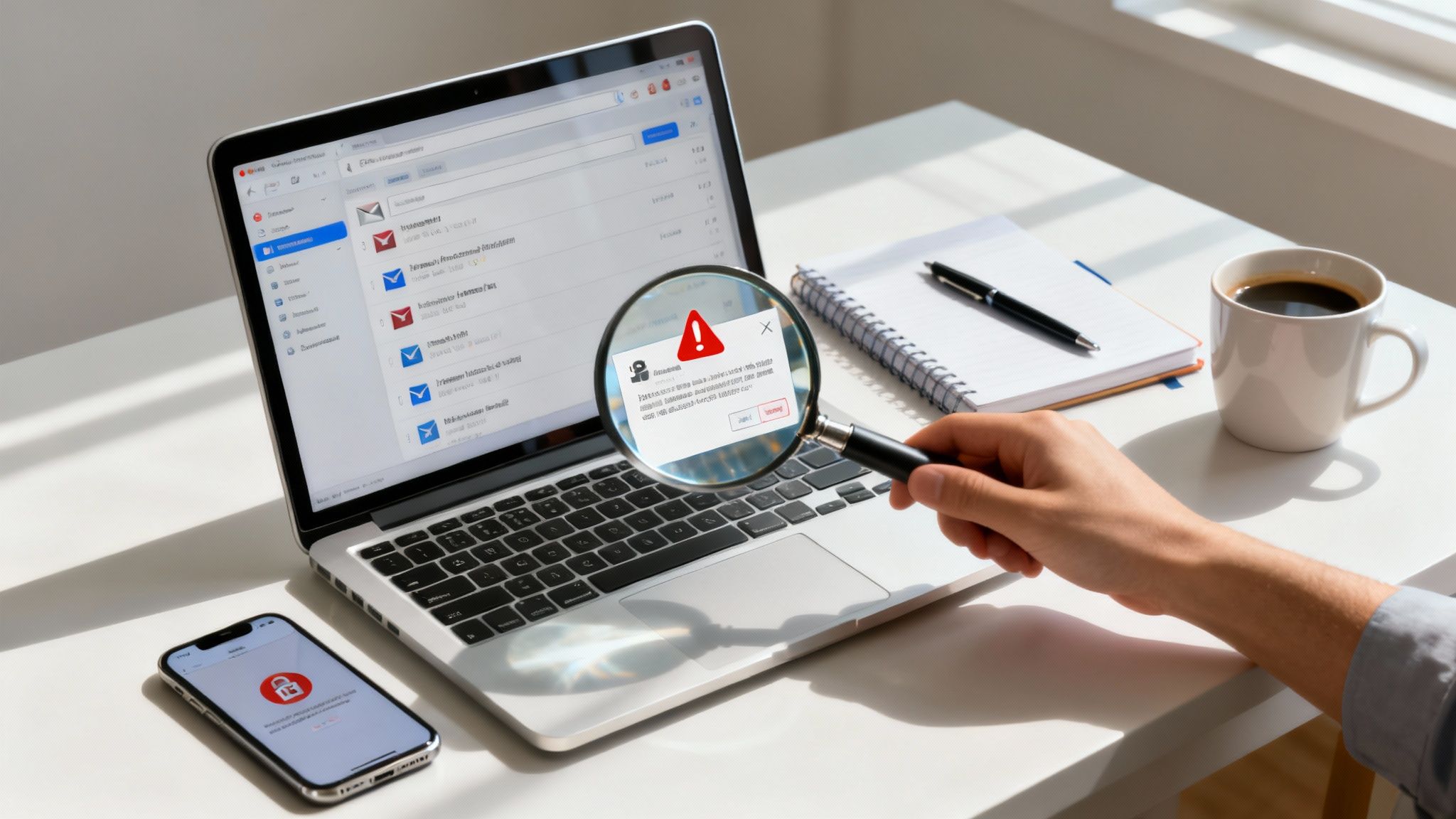· Digital Footprint Check · Content Marketing · 22 min read
How to Remove Negative Search Results Effectively
Learn how to remove negative search results with expert tips. Clean up your online reputation and take control of your digital footprint today!

Before you can clean up your online reputation, you have to know exactly what you’re dealing with. Trying to remove negative search results without a full picture is like sailing without a map—you might fix one problem while three others you never saw coming sink your ship. A proper audit is your blueprint for damage control.
The goal here is to create a strategic inventory of every negative mention, where it’s coming from, and how much damage it’s actually doing. This goes way beyond just Googling your name. It’s a methodical deep dive to uncover everything from old news articles and bad reviews to forgotten social media posts and unflattering public records.
Documenting and Categorizing Every Result
Your first move should be to open up a simple spreadsheet. This is where you’ll track everything you find. For each negative result, you need to log a few key details to keep things organized:
- The exact URL where the negative content lives.
- The search query that makes it pop up (e.g., “Your Company reviews,” “Your Name scam”).
- A quick description of the content and why it’s a problem.
- The type of content it is (news article, review, forum post, etc.).
- Your level of control over it (e.g., you own the account vs. it’s on a third-party site).
Laying it all out like this gives you a bird’s-eye view of the situation. You’ll start to see patterns and can figure out where to focus your energy first. This infographic offers a simple decision tree to help you sort through what you find.

This kind of visual guide really simplifies the process, helping you decide which results need immediate attention and what your best line of attack will be for each one.
Assessing the Damage and Prioritizing Your Actions
With all your findings documented, it’s time for triage. Not all negative results are created equal. A damaging article from a major news outlet sitting at the #1 spot for your name is a five-alarm fire. An obscure forum post buried on page five? Not so much.
This ranking process is critical. Consider this: 74% of consumers will walk away from a purchase if they find negative content on the first page of search results. That’s a massive impact you can’t afford to ignore.
Your goal isn’t just to find the bad stuff, but to understand its visibility and influence. Prioritize the items that show up on page one for important search terms—those are the ones doing the most harm.
To help you sort through this, here’s a quick reference matrix. Think of it as a cheat sheet for categorizing what you find and deciding on the best first move.
Negative Result Triage Matrix
| Result Type | Potential Impact | Primary Strategy |
|---|---|---|
| Negative News Article | High - Wide reach, high authority | Suppression, Right to Be Forgotten (if applicable) |
| Bad Customer Review | Medium-High - Influences purchasing decisions | Direct response, encouraging positive reviews |
| Forum/Reddit Thread | Medium - Can rank for long-tail keywords | Engagement, suppression, comment removal requests |
| Public Record/Mugshot | High - Can be highly damaging to personal reputation | Legal removal services, de-indexing requests |
| Negative Social Media Post | Varies - Depends on the platform and reach | Contact the poster, report policy violations |
| Outdated/Incorrect Info | Low-Medium - Causes confusion | Contact webmaster for updates/corrections |
This matrix helps you move from “Oh no, there’s bad stuff online!” to a clear, actionable plan based on the type and severity of each result.
A thorough audit gives you the clarity to build a real strategy. For a deeper dive into the principles of protecting your brand, check out these online reputation management best practices. And if you need more guidance on this first crucial step, our full guide on https://www.digitalfootprintcheck.com/digital-cleanse-how-to-conduct-a-personal-online-audit has you covered.
With a complete inventory in hand, you can finally shift from reactive damage control to proactive, effective reputation repair.
Pursuing Direct Content Removal at the Source
 The cleanest, most permanent way to get rid of a negative search result is to have the content deleted from the website where it lives. Once the source content vanishes, search engines will eventually drop it from their results.
The cleanest, most permanent way to get rid of a negative search result is to have the content deleted from the website where it lives. Once the source content vanishes, search engines will eventually drop it from their results.
This approach goes straight to the root of the problem, offering a definitive fix. While it’s not always an option, going for direct removal should usually be your first move. You have more leverage than you might think, especially when the information is old, flat-out wrong, or violates the site’s own rules.
Start with Content You Control
Before you start firing off emails to strangers, grab the low-hanging fruit: content you published yourself. Think about all the digital breadcrumbs you’ve left over the years on forums, social media, and old blogs. A fiery comment you left on a forum a decade ago or a cringey photo on a forgotten MySpace page can still rank surprisingly well.
This is your easiest win. Go through your audit spreadsheet and pinpoint every piece of content tied to an account you own or once did. The plan here is simple:
- Log in and delete it. If you still have access, this is a quick and satisfying fix.
- Recover the account. Forgot the password? Use the site’s account recovery tools to get back in.
- Delete the entire account. Sometimes, the content is part of a larger profile. Understanding different account deletion procedures can be your fastest route. Nuking the whole profile usually takes all associated posts and comments with it.
This kind of digital housekeeping is a fantastic first step in learning how to remove negative search results because it puts the power squarely in your hands.
Crafting an Effective Removal Request
What about negative content on a site you don’t own—like a blog, a small news site, or a forum? Your next move is to contact the site owner, webmaster, or author. Success here often comes down to your approach. A demanding or aggressive email will get you ignored, fast.
Your communication should be polite, professional, and to the point.
- Be Respectful: Remember, you’re asking for a favor, not making a demand. A little courtesy goes a long way.
- Be Specific: Provide the exact URL of the page you want removed. Don’t make them search for it.
- Be Concise: Webmasters are busy. Briefly explain the issue and what you’re asking for without a long, emotional backstory.
Your request will be much stronger if you have a valid reason. If an article contains factual errors, show them proof. If a post shares your personal contact info without permission, that’s a powerful justification for removal.
A respectful, well-reasoned request that makes the webmaster’s job easy has a much higher chance of success. Frame your request around fairness, accuracy, or privacy—not just your personal dissatisfaction.
Knowing When to Pivot Your Strategy
The hard truth is, direct requests won’t always work. Large news organizations almost never take down articles, though they might issue a correction. Some webmasters will just ignore you, while others might flatly refuse. You have to know when you’ve hit a wall.
If your first polite email gets no response, sending a single follow-up after a week or so is reasonable. But bombarding them with messages will only backfire.
If direct removal isn’t happening, don’t panic. It just means it’s time to shift tactics to other powerful strategies, like getting the page de-indexed from Google or launching a suppression campaign to bury it.
Using Google’s Official Removal Tools
When you’ve hit a wall with a website owner—or can’t reach them in the first place—your next move is to go straight to the source: the search engine itself. While Google can’t force a website to delete content, they can remove a page from their search index. This process, called de-indexing, makes the content effectively invisible to the public. It’s your second line of defense in the battle over how to remove negative search results.
https://www.youtube.com/embed/bTNfF7f83vs
But here’s the catch: Google operates under a strict, almost legalistic, set of rules. You can’t just ask them to take down an article because you don’t like it or find it unflattering. To be successful, the content has to violate one of their specific, clearly defined policies. This isn’t about opinions; it’s a technical process that requires you to build a solid case.
Understanding Google’s Removal Policies
Google’s removal policies are all about protecting users from tangible harm. They aren’t interested in mediating disputes or acting as an arbiter of truth. Instead, they focus on very specific categories of sensitive and dangerous content.
You’re most likely to see action when the content involves:
- Personally Identifiable Information (PII): This is the big one. We’re talking about exposed confidential government ID numbers, bank account or credit card details, or even images of your signature.
- Doxxing: This goes beyond just sharing information. It’s when someone posts your home address, private phone number, or personal email with an explicit or implied threat of harm.
- Nonconsensual Explicit Imagery: Any intimate, personal photos or videos shared without your permission fall into this high-priority category. Google takes this very seriously.
- Content on Sites with Exploitative Removal Practices: Think “mugshot” or “online shaming” sites. These are platforms that post personal information and then demand a fee to take it down.
Getting negative search results wiped completely is rare. That’s why a smart strategy often involves a mix of deletion, de-indexing, and suppression. When you can’t get something deleted, getting it de-indexed is the next best thing. If you’re looking for more ways to manage your online presence, it helps to explore proven SEO strategies for 2025.
Submitting a Removal Request Through “Results About You”
To make this process a little less painful, Google created a centralized dashboard called “Results About You.” This tool is designed to help you flag URLs containing your personal information and track your removal requests all in one place.
You can find the tool within your Google Account settings. Once you’re in, the process is straightforward: you provide the URLs of the pages containing your PII and the specific search terms that bring them up. Be meticulous here. Provide the exact URLs and even screenshots to back up your claim. The more evidence you give them, the better.
Here’s a look at the tool’s starting screen, where you kick off a new request.
The interface walks you through everything, asking for the URL and the type of personal info it contains. This helps Google’s review team get right to the point and assess your case efficiently.
Using the Outdated Content Removal Tool
So what happens when a webmaster actually removes or updates a negative page, but the old, damaging version is still showing up in search results? This is a surprisingly common and frustrating problem. It just means Google’s cache hasn’t caught up with the live website yet.
For this exact situation, Google created the “Remove Outdated Content” tool. It’s crucial to understand this tool is only for content that has already been changed or deleted on the original website. It will not work on live content you just want removed.
You simply submit the URL, and the tool crawls the page to confirm that the offending content is gone or has been significantly changed.
Pro Tip: Whenever you ask a webmaster to remove a page, also ask them to update their sitemap and request a re-crawl in Google Search Console. This sends a direct signal to Google that the site has been updated, which can seriously speed up the de-indexing process.
If the tool confirms the page has been updated, it will fast-track the removal of the old, cached version from Google’s search results. This is a critical final step to make sure your successful removal effort is actually reflected in what the public sees. Working with these tools can take some patience, but they are incredibly powerful when your situation fits within Google’s strict guidelines.
Suppressing Negative Links with Positive SEO
So, you’ve sent the takedown requests and hit a wall. Don’t worry, you’re not out of options. The next strategy in tackling negative search results isn’t about removal at all—it’s about suppression. Think of it as burying unwanted content with an avalanche of positive, high-quality information that you control.
The goal is refreshingly simple: push the bad stuff so far down Google’s rankings that it becomes practically invisible. And it works. Less than 1% of users ever bother clicking to the second page of search results. This isn’t just defense; it’s a proactive campaign to seize control of your narrative and define your own online reputation.
Building Your Digital Fortress
At the heart of any good suppression campaign is creating and optimizing digital assets that can outrank the negative link. You’re essentially building a digital fortress around your name, and it starts with a strong presence on high-authority platforms that Google already knows and trusts.
Your first move should be to lock down a network of properties you fully own. These will become the cornerstones of your positive online presence.
- A Personal or Professional Website: This is your home base online. Grabbing a domain name that matches your personal or business name (like
YourName.com) gives you a massive ranking advantage right out of the gate. - Key Social Media Profiles: Platforms like LinkedIn and X (formerly Twitter) have incredible domain authority. A well-optimized profile on these sites can easily land on the first page for name searches. Even a professional Facebook page can be a powerful asset.
- High-Authority Blogging Platforms: Using sites like Medium or adding a professional blog to your own website lets you publish long-form content. This is your chance to showcase expertise and share your perspective.
By consistently putting out valuable content on these platforms, you’re sending strong signals to Google that these positive sources are the most relevant results for your name. To get the most out of these profiles, our guide on steps to curate a positive online image has some great, actionable tips.
Leveraging Third-Party Platforms
Beyond what you own, you can seriously expand your reach by contributing to other authoritative websites. This tactic lets you borrow the credibility and ranking power of established platforms to keep pushing that negative content further down.
Look for opportunities to write guest posts on industry blogs, participate in interviews that will be published online, or create a profile on a respected professional directory. Every piece of content you place on a third-party site acts as another positive asset competing for a top spot in search results.
The core idea is to diversify your positive footprint. The more high-quality, relevant pages that exist about you online, the less weight any single negative page will carry in Google’s algorithm.
This table breaks down some of the best platforms to use for content suppression, giving you a better idea of where to invest your time for the biggest impact.
High-Authority Platforms for Content Suppression
| Platform | Ranking Potential | Content Type | Time Investment |
|---|---|---|---|
| Personal Website/Blog | Very High | Articles, case studies, portfolio | High (ongoing effort) |
| LinkedIn Profile | High | Professional history, articles, posts | Medium (regular updates) |
| Medium/Substack | Medium-High | Long-form articles, opinion pieces | Medium (consistent publishing) |
| Guest Posts | Varies | Industry-specific articles | Varies (depends on outreach) |
| X (Twitter)/Facebook | Medium | Short updates, links, engagement | Low (daily activity) |
As you can see, the properties you own offer the most control and ranking potential, but leveraging other platforms helps build a more robust and diverse digital presence.
The Power of Foundational SEO
Creating content is only half the job. You have to optimize it. This is where some basic Search Engine Optimization (SEO) becomes your most powerful tool. No need to become an expert overnight, but a few key principles are non-negotiable.
Your primary goal is to optimize each positive asset for your name—or whatever search query is pulling up the negative result.
This means focusing on three key areas:
- On-Page Optimization: Make sure your target keyword (e.g., “John Doe”) shows up in crucial spots like the page title, headings, and a few times naturally within the text.
- Content Quality: This is critical. A thin, spammy-looking profile won’t fool Google. Write detailed bios, publish genuinely insightful articles, and share relevant updates that prove you’re the real deal.
- Strategic Linking: This is how you build authority. Your personal website should link out to your LinkedIn profile. Your X profile should link back to your website. This creates a powerful web that tells search engines all these positive assets are connected and important.
This interconnected network of positive content builds momentum over time. Each new article, profile, or guest post adds another brick to your digital fortress, making your reputation stronger and more resilient. Suppression is a long game, but it’s the most reliable way to regain control and shape how the world sees you online.
Dealing With Bad Reviews on Major Platforms
Negative reviews are often the most visible—and most damaging—content that will pop up when people search for you. A single furious comment on Google, Yelp, or Trustpilot can rank highly in search results, hitting your customer trust and bottom line directly. You can’t just ignore them; you need a specific game plan that mixes direct removal attempts with smart reputation building.
Unlike a news article or an angry blog post, reviews live on platforms that have their own rules and moderators. This actually works in your favor, giving you a clear path for removal that doesn’t exist for other types of content. Your first move should always be to figure out if the review breaks the platform’s own terms of service.
Spotting and Flagging Policy Breaches
Every major review site has a list of content guidelines. Most of them are common sense—they prohibit things like hate speech, spam, harassment, or obvious conflicts of interest (like a review from a competitor or a bitter ex-employee). If a negative review crosses one of those lines, you have a legitimate case for getting it taken down.
Your job is to build that case. Run through this checklist every time you see a damaging review:
- Is personal information exposed? Does the review share an employee’s full name, private phone number, or other personal data? This is a common and serious violation.
- Is it an off-topic rant? Is the reviewer actually talking about your business, or are they just venting about something completely unrelated? Off-topic content is often removable.
- Does the account look fake? Check the reviewer’s profile. Does it seem suspicious or like it was created just to leave that one negative comment? If so, flag it.
- Is there prohibited content? Any profanity, threatening language, or discriminatory speech? These are usually the easiest violations to get removed.
When you do flag a review, be specific. Don’t just click the “report” button and hope for the best. Use the text box they provide to explain exactly which policy was violated and quote the specific language that proves your point. This makes the moderator’s job a whole lot easier and seriously boosts your chances of success.
Drown Out the Negative with Positive Feedback
Let’s be real: you won’t get every negative review removed. Some are just legitimate, unhappy customers sharing their experience, and they have a right to do that. When removal isn’t on the table, your next best move is dilution. The idea is to bury the bad feedback under a wave of positive reviews from your real, satisfied customers.
A single one-star review just doesn’t hit the same when it’s surrounded by dozens of four- and five-star ratings. This isn’t about paying for fake reviews—it’s about actively encouraging your happy clients to share their thoughts. You can set up simple systems, like sending a follow-up email after a purchase or putting a QR code on receipts that links right to your Google review page.
An analysis of almost 50,000 deleted Google reviews showed that Google is actively moderating its platform, which has a direct effect on a business’s local SEO. Staying on top of your review profile is a core tactic for controlling what people see when they search for you. You can see more data on these review removal trends at localo.com to sharpen your own strategy.
Key Takeaway: A steady stream of authentic, positive reviews is your best long-term defense against the harm of negative ones. It’s a proactive approach that builds trust while pushing down the content you don’t want people to see.
Turn a Complaint into an Opportunity
Even when you can’t get a bad review taken down, you can still control the story by responding to it publicly. A professional, thoughtful reply can neutralize the damage and even make you look good to potential customers. It shows that you’re paying attention, you care, and you’re ready to solve problems.
Your response should always be:
- Quick and Professional: Acknowledge the complaint right away without getting defensive.
- Empathetic: Show you understand their frustration. Something as simple as, “I’m sorry to hear you had a frustrating experience,” goes a long way.
- Action-Oriented: Offer a solution and move the conversation offline. “Please contact us at… so we can make this right,” is a perfect example.
This approach puts excellent customer service on display for everyone to see. It proves you aren’t afraid of criticism and that you stand behind your business. To make sure you never miss a new review, it’s a good idea to use some of the top tools for monitoring your digital footprint so you can jump on it immediately.
Common Questions About Reputation Repair
Jumping into the world of reputation repair can feel like navigating a maze. It’s a space filled with nuance, where timelines are anyone’s guess and solid guarantees are hard to come by. Let’s tackle some of the most common questions people have when they decide it’s time to learn how to remove negative search results. Getting realistic answers is the first step to setting the right expectations.
One of the first things on everyone’s mind is the timeline. How long does it actually take to make a negative result disappear or at least get it off the first page?
The honest answer? It varies. A lot. If you’re just deleting content you personally control, like an old cringey blog post, you could see it vanish from Google’s index in just a few days. But if you’re asking a third-party site to take something down, that could involve weeks of back-and-forth emails… if they even agree to it at all.
Suppression campaigns are a different beast entirely. Think of it as a long-term project, not a quick fix. You’ll often need three to six months of steady, consistent work before you start seeing a real shift in the search rankings.
The biggest things that will affect your timeline are the complexity of the content and the authority of the website it’s on. Removing a nasty comment from a small-time forum might be a weekend project. Trying to outrank a negative article from a major news outlet? That’s a months-long campaign, easy.
Can I Do This Myself or Do I Need a Professional?
Another big question is whether you should try to handle this on your own or bring in a professional service. The right call really depends on your specific situation—your budget, how much free time you have, and just how bad the problem is.
A DIY approach is totally fine for simpler issues. If you’re only dealing with a few negative results on sites that have clear takedown policies, or you feel confident you can create your own positive content to suppress the bad stuff, you can get a lot done by yourself.
However, you should really think about hiring a professional when:
- The stakes are high. If these negative results are costing your business serious money or doing major damage to your personal life, the investment in expert help is almost always worth it.
- You’re dealing with legal issues. Things like defamation, copyright violations, or content that needs a court order to be removed demand real legal expertise. That’s far beyond what a DIY effort can handle.
- The problem is all over the place. If you’re staring down dozens of negative links across a bunch of different platforms, a reputation management company has the tools and experience to fight that battle at scale.
- You just don’t have the time or skills. Effective suppression is a marathon, not a sprint. It requires a sustained SEO strategy. If you can’t commit to that, an agency can run the whole process for you.
Professionals simply bring established systems and specialized tools to the fight, which can speed things up and help them navigate tricky situations more effectively.
What Is a Realistic Success Rate for Removal?
It’s so important to be realistic about what “success” actually means here. Getting a negative search result completely deleted is the dream scenario, but honestly, it’s often the least likely outcome. This is especially true when the content is hosted on a high-authority site like a news publication.
It’s better to think about success in a few different tiers:
- Full Removal: The content is wiped from the source website. This is the home run, but it’s tough unless you’re the one who posted it or it clearly violates a site’s terms of service.
- De-indexing: The webpage stays live, but Google is instructed to remove it from its search results. This is a fantastic solution for things like personal information violations or other specific policy breaches.
- Suppression: The negative result gets pushed down to the second page of Google or even lower, where almost no one will ever find it. For most situations, this is the most realistic and effective long-term goal.
Some research shows that fewer than 1% of people searching on Google ever click on a result on the second page. So, if you can successfully suppress a negative link, it’s pretty much just as effective as getting it removed for the vast majority of people who look you up. Keeping your expectations in check is the key to getting through this process without a ton of frustration.
Ready to take back control of your online story? It all starts with a deep dive into your digital footprint. Digital Footprint Check scours the web to find every mention of your information, giving you the complete map you need to start your reputation repair journey.



